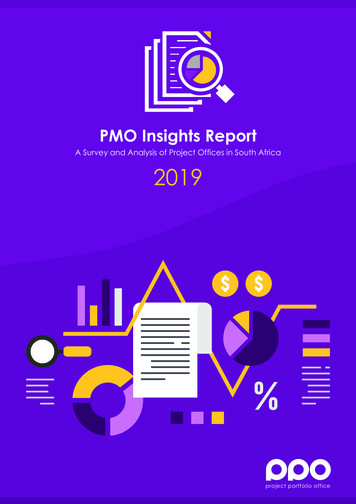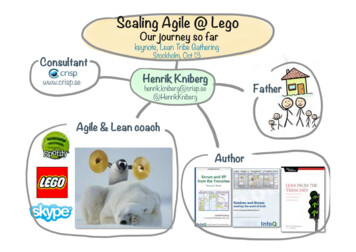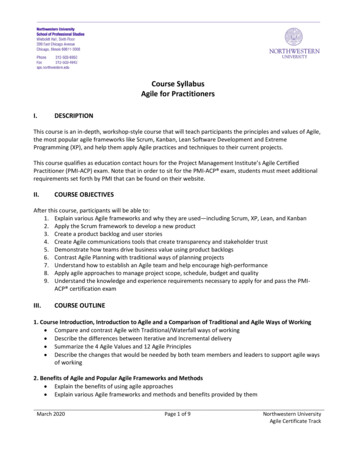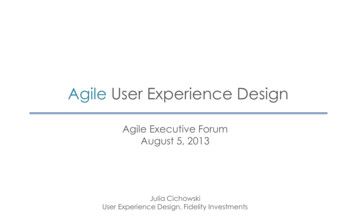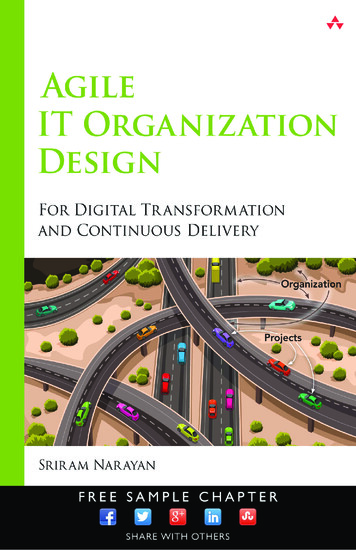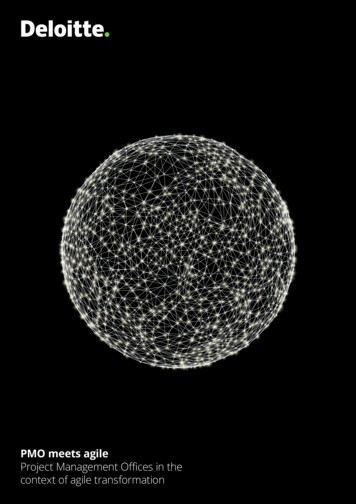
Transcription
PMO meets agileProject Management Offices in thecontext of agile transformation
PreambleAccording to theory and the opinion ofmany experts, PMOs and agile projectscannot be reconciled. Responsibilities andaccountabilities that were originallyassumed by a PMO are increasingly beingshifted to agile teams - a world that is toooften not realistic at all.Therefore, the following point of viewanalyzes the current reality. It shows thatalthough many companies want tobecome agile, they often only aim tomake classic project managementprocesses more flexible and dynamic.So an answer should be given to howagile trends influence the work of PMOsand how they can generate maximumadded value in the described realities.02
PMO meets agile Project Management Offices in the context of agile transformationPMO 4.0:The influence of agile methodologyon traditional PM standards04Agile PMO structure:Social rethinking and changing values08The PMO transformation:Examples of more flexible processes and tools10ConclusionIncreased benefit through more flexibility1203
PMO 4.0:The influence of agilemethodology on traditionalPM standardsMegatrends such as globalization anddigitization force companies to act fasterand more flexibly. Many companieschange their procedures or start agiletransformation projects as a way to meetthe new requirements. Often, consciouslyor unconsciously, organizations choose ahybrid approach between the traditionalwaterfall and agile methodology aiminga feasible and ideal project dynamic. Thishybrid model brings the best of bothworlds together, finding a common workingsystem: a change process that affects allareas of traditional project managementand leads to agile product development.Fig. 1 – Tasks of a modern 04CostManagementPlanning& ScopeManagementStakeholder& ChangeManagementResource& VendorManagementPlan
PMO meets agile Project Management Offices in the context of agile transformationStandard project management roles – suchas Project Manager, Project Sponsor, PMO,etc. – are still present in many projects.Although the PMO role is not the focusof traditional scrum philosophies, theincreasing interest in agile transformationleads to an extension of the fundamentalunderstanding of project management (seealso PMBoK Guide 6th Edition) and thusalso of PMO.Agile methods, such as Scrum, are oftenseen as a “means to an end” for transformation projects. The benefits of agile management have been proven outside thesoftware development field and found theirplace in many project management theories. The adoption of modern approachesis driven in particular through disadvantages of the waterfall method: Theyfrequently do not represent a progressivemanagement approach, since proceduresare often too slow and inflexible; accordingto the waterfall method, especially in thefirst project phases, structure appears tobe more important than the actual productand project bureaucracy becomes its owntime-consuming concept.Agile Transformation combines flat hierarchies with efficient communication andaction strategies that create an iterativeapproach to the execution of prioritizedtasks. Incremental procedures can beused to re-prioritize tasks more flexibly atdefined points in time. Sprints are carriedout in defined, short periods of time andideally always deliver a “finished”, alreadytested and operational (part) product.The focus of this approach is on tailormade quality and performance, individualempowerment and a solution-orientedcooperation of all participants.The performance of an agile PMO canbe tracked by how the number of sprintsdeliver maximum value to the companybusiness, considering “traditional disciplines” such as time, budget and scope. Forthis purpose, there are increasingly specialized offers on the market, such as theDeloitte Predictive Project Analytics (PPA).With this method, a PMO can use sevendomains and up to 172 factors to measureproject performance and thus the probability of success at an early stage. Althoughtraditional PMO tasks such as processconsideration, tool selection/operationand uniform quality standards maintainrelevance to performance review in an agilesetting, their role is now a secondary one at least in intermediary stages.An agile PMO – increasinglyknown as Agile ManagementOffice (AMO) – has numerousadvantages over traditionalproject coordination: High valueorientation, self-organization,faster reaction times, efficientmanagement of digital projectsand customer experience.05
Fig. 2 – Dynamically networked PMOProject 1Project 2Since traditional project management usesa project handbook to regulate qualitystandards right from the beginning of theproject, compliance with the quality criteriais checked iteratively in agile projects.Project 3versusAgile management office (AMO)06Project 1Project 2Project 4Project 3Project 4The PMO, depending on its design orintended sphere of influence, executesa central function in promoting projectmanagement standards and processes.It is responsible for ensuring that moreagile working methods are used in theorganization. The PMO defines which PMmethodology has to be used and musttherefore be up to date and take agilitytrends into account.
PMO meets agile Project Management Offices in the context of agile transformation07
Agile PMO Structure:Social rethinking andchanging valuesAgile project management cannot replacethe classic per se; both methods have theirfields of application in which they can behelpful. For example, a pure “Scaled Scrum”can be successful in very few cases. This isdue to existing organizational structureswithin the companies as well as knownfundamental challenges in transformingprocedures and processes. The agile scaling requires cultural change and adaptationof structures, which are made possible byclassic PM methods.The key to success, especially for HybridAgile, lies in harmonizing agile methodswith a PMO as a tool of classical projectmanagement. The same applies to relatedcapabilities such as program managementor portfolio management (see also Figure 3).An agile PMO can unite the best of bothworlds and is a step towards a more agileproject management. Hybrid projectsusually have an agile core surrounded bya supporting PMO structure. During thesprints, the team develops the planneddelivery objects on the basis of so-calleduser stories. The PMO accompanies theprocess to ensure the necessary framework conditions. In such a scenario, thePMO provides added value, especially insprint overlapping areas of governance,organization and communication.08Agile transformation is characterizedby flexibility and speed. However, suchdynamic environments often lack stableand documented structures. The use ofcross-unit status and control documents –in conjunction with clear governance structures – supports the agile project structure.The increased use of governance structures and documents facilitates projectentry for employees who are not part ofthe team or the general project contextfrom the outset. Project information suchas onboarding materials, organizationalcharts, processes, and other documentsare created and maintained by PMO, accessis provided, and accounts are administered.Therefore it is recommended to positionthe PMO as a cross-sectional functionabove the individual agile teams. Byestablishing standards in a central PMO,resources and tasks can be coordinatedacross projects, so that the effort for allparticipants is reduced to a minimum. Theholistic view, which the PMO holds throughits superior position, supports the sharingof knowledge and experience between theindividual agile teams.The PMO's structured support significantly
PMO meets agile Project Management Offices in the context of agile transformationrelieves Scrum Master and Product Owner,as explained in the chapter “PMO Transformation”. As a comprehensive instanceto the agile teams, the PMO assumes anadditional interface function between allstakeholders and can communicate in thisrole both the basic project vision as wellas the sprint progress which is subject to aregular cycle. Many projects lead to organizational changes on a significant scale dueto innovations or adaptations. Internalcompany communication about the changefrom classic PM processes to agile workingmethods is not only important to maintainthe general working morale, but also to winthe sympathy of relevant stakeholders forthese changes.Availability and productivity of team andmanagement are increased, providingmore room for customer interaction andexpectation management.In addition, experienced PMO employeesusually have the necessary knowledgeand are well networked with the relevantstakeholders to ensure efficient resourcemanagement and create a framework inwhich technical experts and developerscan work together optimally on a daily basisduring the project. The resulting efficiencygains allow agile teams to concentrate fullyon their actual work.The PMO is well positioned to initializeimportant dialogues “up” and “down”: Forexample, the PMO can set up sprint newsletters for the operational teams and ane-mail address for questions about technical innovations through the completedsprints. In addition, PMO can managecommunication with clients and sponsorson the customer side and, for example,accept questions or organize informationmeetings.Fig. 3 – IT Transformation covered by four capabilitiesPortfolioManagementPMOExcellenceIT TransformationManagement @ DeloitteProgramLeadershipAgileTransformation09
The PMO transformation:Examples of more flexibleprocesses and toolsGiven an appropriate allowance and empowerment, the PMO has thepossibility to take on a central function in the agile project organization.It helps the project teams to live agile values and to secure the teams'decision-making autonomy. The already existing PMO can support theScrum Master in conveying the new agile principles and requirementsto the teams with the help of trainings.The first step towards PMO transformationis to carry out an inventory or an analysisof the PM methodology used by the PMO.By means of this inventory, one can drawthe first conclusions as to whether theproject management of a company hasalready been enriched or improved bynew methods.By creating a method concept, the projectmanagement methodology in the companyis supplemented and it is also determinedwhich methods should no longer beapplied in the future.Increasingly, the PMO appears like an outdated function in the context of the agiletrend: older, intent on rules and order, andquite in contrast to the young and euphoricprotégé who wants to dominate the pictureand more and more does so in practice.This of cause is very strikingly spoken, yet itis relevant in so far as the PMO often nolonger acts in a contemporary manner. Thefollowing points are suggestions on howthe PMO can change to be dynamicallypositioned in an agile hybrid environment.10
PMO meets agile Project Management Offices in the context of agile transformationRigidprocessesThe term “process” is usuallyundisputedly associated withthe PMO; the addition “rigid”is often added with certainty,at least silently. The problemthat many PMOs face is a predominance of already existing,inflexible processes, whichusually stifle any innovation atits core and determine purelyreactionary action.To simply abandon processesto PMO and any methodologywould be against the actualnature and also the originalpurpose of PMO. Processesenable job execution, butneed a flexible agenda for adynamic environment. It isgood to maintain a portfolioRigidstructuresJust like too much bureaucracy, a rigid PMO (e.g.numerous hierarchy levels,fixed and long decision paths)is also a hindrance to projectexecution. In addition, therigid structures are no longercompatible with the expectations of ambitious employees:instead, they encourage theassumption of responsibilityand the possibility of self-determination.Here, too, the agile philosophyis much better suited tocurrent challenges than thewaterfall approach: Eachindividual in the project –including the PMO – is responsible for the final work result.With this focus on the directimpact on success or failure,the motivation and sense ofFlexibleprocessesof proven methods, but theapplication should be questioned and rethought foreach situation or issue. At thesame time, flexible processesshould move the reactivefocus towards an earlyanticipation of situations inorder to enable a progressiveapproach to specific topics.For example, flexibleescalation processes canhelp to identify problemsoccurring in the project asearly as possible and totreat them openly. In otherwords, trends are identifiedearly on and counteracted ifnecessary.Selfresponsibilityresponsibility of all participants usually increases.The agile managementmethodology also workswith the concept of the“space of trust” within everyagile team; this means thatsuggestions and constructive criticism can be freelyexpressed within the teamat any time in order to findan improved solution regardless of position orexperience. The quality ofwork is enhanced by both:employees feel encouragedto express their opinionsand make decisions. Asecure platform to expressthoughts and observationssupports an environmentof unbridled creativity andproductivity.OldbureaucracyThe PMO has its origins in thewaterfall methodology, whichwas conceived at a time whenfewer external influences,or rather, these had a muchslower impact on projects.Nowadays, the requirementsfor project management,as for all company components, are moving forwardat a much higher pace. APMO with traditionally longcoordination processes andinflexible internal hierarchylevels tends to act like a fossilfueled by the volatility ofinternational markets.A cornerstone for bringingmore modernity to PMOorganization is the theoryTraditionaltoolsIn conventional project management, those responsibleplan the financial, personneland material expenditurein advance and align theentire project managementprocess as well as the supporting tools with this planning. Only small divergencesfrom this assessment aretolerated.According to this procedure,the project is processedstep by step in a fixed orderwith the help of traditionalproject management tools.Processes based on thewaterfall model are mostlyused in companies withpronounced hierarchicalstructures. In contrast tothis, market requirementsexpect project managementLeanmanagementof lean management. If theexisting PMO working methods are reduced to thosethat are actually useful, theexisting bureaucratic layers areremoved. Employees are givenmore responsibility and havethe opportunity to make theirown decisions. A “lean” PMOprovides the ideal basis forreacting directly to acute questions or project requirements.Flat hierarchies and management paths simultaneouslyreduce the required workingtime and the associated costsconsiderably and increase notonly the success of the projectbut also the efficiency of thePMO.Agiletoolstools to react immediately toshort-term changes and to bestructurally “agile” specialized(e.g. by taking sprint backlogs,epics, agile roles, etc. intoaccount).An agile project organizationalso benefits from the righttools. On the one hand, teamsneed methodical training inagile work. PMO, for example,can assume this role. Onthe other hand, teams needtools to document upcomingtasks, project progress andfurther planned steps in an“agile-compliant” way.11
Conclusion:Increased benefitthrough more flexibilityAs a result of digitalization, projects arebecoming increasingly complex. The use oftechnology to manage projects is expandingand project teams must be cross-functionalin order to achieve project goals. Agile project organization represents an opportunityto react more quickly to new requirementsand, as a result, be more visible on the market. For companies with a traditionalapproach to project organization, the transformation to an agile PMO is part of theirdigital and agile transformation.At this point it should be emphasized that itis not about the evaluation of “better” or“worse” methods. Because each projectmanagement method can unfold itsstrengths, if applied correctly. It is essentialto consider, use and improve them.In today's immediate and dynamicbusiness environment, agileworking methods offer added valuethat should not be underestimated.In the context of an agile hybridtransformation, the change to moreflexible PMO structures is a must.12
PMO meets agile Project Management Offices in the context of agile transformation13
ContactJochen FauserPartnerLead Technology Strategy & Architecturejfauser@deloitte.deCarlos Almería AbadSenior ConsultantTechnology Strategy & Architecturecalmeriaabad@deloitte.de14Matthias AlbrechtManagerTechnology Strategy & Architecturemalbrecht@deloitte.de
PMO meets agile Project Management Offices in the context of agile transformation15
This communication contains general information only not suitable foraddressing the particular circumstances of any individual case and isnot intended to be used as a basis for commercial decisions or decisionsof any other kind. None of Deloitte GmbH Wirtschaftsprüfungsgesellschaft or Deloitte Touche Tohmatsu Limited, its member firms, ortheir related entities (collectively, the “Deloitte network”) is, by means ofthis communication, rendering professional advice or services. No entity in the Deloitte network shall be responsible for any loss whatsoeversustained by any person who relies on this communication.Deloitte refers to one or more of Deloitte Touche Tohmatsu Limited, aUK private company limited by guarantee (“DTTL”), its network of member firms, and their related entities. DTTL and each of its member firmsare legally separate and independent entities. DTTL (also referred to as“Deloitte Global”) does not provide services to clients. Please see www.deloitte.com/de/UeberUns for a more detailed description of DTTL andits member firms.Deloitte provides audit, risk advisory, tax, financial advisory and consulting services to public and private clients spanning multiple industries; legal advisory services in Germany are provided by Deloitte Legal. With aglobally connected network of member firms in more than 150 countries,Deloitte brings world-class capabilities and high-quality service to clients,delivering the insights they need to address their most complex businesschallenges. Deloitte’s approximately 286,000 professionals are committedto making an impact that matters.Issue 09/201916
PMO meets agile Project Management Offices in the context of agile transformation 05 Standard project management roles – such as Project Manager, Project Sponsor, PMO, etc. – are still present in many projects. Although the PMO role is not the focus of traditional scrum philosophies, the inc
